Centauri Dreams
Imagining and Planning Interstellar Exploration
Pluto: Unusual Interactions with the Solar Wind
David McComas (Princeton University) calls what his team of researchers have learned about the solar wind at Pluto ‘astonishing,’ adding “This is a type of interaction we’ve never seen before anywhere in our Solar System.” The reference is to data from the Solar Wind Around Pluto (SWAP) instrument that flew aboard New Horizons. McComas knows the instrument inside out, having led its design and development at the Southwest Research Institute.
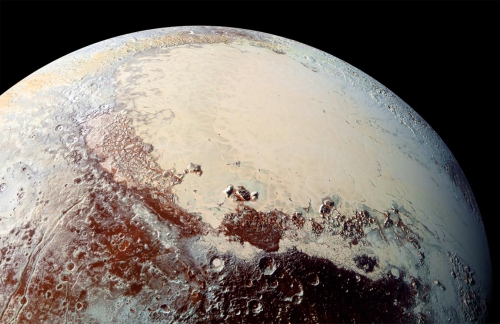
Image: The first analysis of Pluto’s interaction with the ubiquitous space plasma known as the solar wind found that Pluto has some unique and unexpected characteristics that are less like a comet and more like larger planets. Credit: NASA/Johns Hopkins University Applied Physics Laboratory/Southwest Research Institute.
What startled McComas was that Pluto’s interactions with the solar wind are nowhere near what had been predicted. This stream of charged particles flowing outbound from the Sun can reach speeds of 500 kilometers per second and above, a ragged, bursting outrush that we may one day be able to capitalize on as a way to drive spacecraft. While planets act to divert the solar wind, comets slow it far more gently, an effect that researchers assumed they would find at Pluto.
Instead, Pluto’s complexities place it somewhere between planet and comet as its atmosphere copes with the solar wind. We learn in the paper from McComas and team that despite expectations, Pluto’s gravity is capable of holding electrically charged ions in its extended atmosphere. The dwarf planet has an ion tail extending ‘downwind’ to a distance of about 100 Pluto radii (120,000 kilometers). Earth has a similar ion tail, and Pluto’s is said to show ‘considerable structure.’
From the paper:
Initial studies of the solar wind interaction with Pluto’s atmosphere…, all assuming the absence of an intrinsic magnetic field, suggested that it would depend on whether the atmospheric escape flux is strong — producing a ‘comet-like’ interaction where the interaction region is dominated by ion pick-up and many times larger than the object — or weak — producing a ‘Mars-like’ interaction dominated by ionospheric currents with limited upstream pick-up and where the scale size is comparable to the object.
And Pluto, we learn, behaves more like its larger planetary cousins, as the image below suggests.
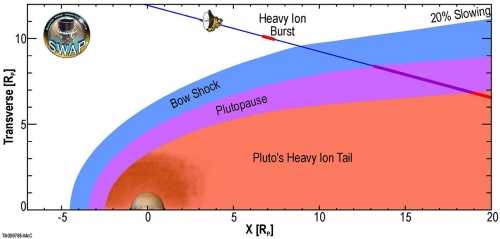
Image: This figure shows the size scale of the interaction of Pluto (at lower left) with the solar wind. Scientists thought Pluto’s gravity would not be strong enough to hold heavy ions in its extended atmosphere, but Pluto, like Earth, has a long ion tail (red) loaded with heavy ions from the atmosphere. Pluto has a very thin “Plutopause” (purple), or the boundary of Pluto’s tail of heavy ion tail and the sheath of the shocked solar wind (blue) that presents an obstacle to its flow. Credit: American Geophysical Union.
The SWAP instrument was able to separate heavy ions of methane, which is the primary gas escaping the atmosphere, from the light hydrogen ions coming from the Sun. From it we also learn that Pluto has a thin ‘Plutopause,’ a boundary region where the heavy ion tail meets the solar wind along a sheath of particles. Moreover, the solar wind is not blocked until it reaches within about about 3000 kilometers of the dwarf planet — the paper calls this the ‘upstream standoff distance’ — a bit less than three Pluto radii.
As the paper notes, we’ll have a good deal of data from different parts of the Solar System to examine as we try to put Pluto into context:
While the small size of the interaction region relative to Pluto is reminiscent of Mars and Venus, we note that recent observations of the solar wind interaction with the relatively weakly out-gassing Comet 67P Churyumov-Gerasimenko by instruments on ESA’s Rosetta spacecraft show deflection of the solar wind with relatively modest decrease in speed. We anticipate interesting scientific discussions of the relative roles of atmospheric escape rate, solar wind flux, and IMF strength at Mars, Comet 67P and Pluto as the data from the MAVEN, Rosetta and New Horizons spacecraft are further analyzed.
And as McComas notes in this Princeton news release, “The range of interaction with the solar wind is quite diverse, and this gives some comparison to help us better understand the connections in and beyond our solar system. The SWAP data will … be reanalyzed … for many years to come as the community collectively grapples with Pluto’s unique solar wind interaction — one that is unlike that at any other body in the solar system.”
The paper is McComas et al., “Pluto’s Interaction with the Solar Wind,” accepted at the Journal of Geophysical Research: Space Physics (abstract / preprint).

C/2014 S3: ‘Manx Object’ from the Oort Cloud
When you don’t have the technology to get to an interesting place like the Oort Cloud, it’s more than a little helpful when nature brings an Oort Cloud object to you. At least we think that the object known as C/2014 S3 (Pan-STARRS) has moved into the warmer regions of the Solar System from the Oort. A gravitational nudge in that distant region would be all it took to send the object, with an orbital period now estimated to be 860 years, closer to the Sun.
And here things get interesting, because C/2014 S3 is the first object discovered on a long-period cometary orbit that shows all the spectral characteristics of an inner system asteroid. The level of activity on the object, apparently the result of sublimation of water ice, is five to six orders of magnitude lower than what we would expect from an active long-period comet at a similar distance from the Sun. Karen Meech (University of Hawaii) and colleagues believe that the object formed in the inner system at about the same time as the Earth, after which it was ejected before it could be bathed by long-term solar radiation.
Meech calls C/2014 S3 “…the first uncooked asteroid we have found,” which means we’re not only dealing with a building block of the early Solar System, but one that has been preserved for billions of years in a pristine environment. Further underlining its unusual status is the fact that C/2014 S3 is not developing the tail we would expect from a long-period comet as it approaches the Sun. Hence the moniker ‘Manx object’ given by Meech and team, a reference to the tail-less breed of cat from the Isle of Man.
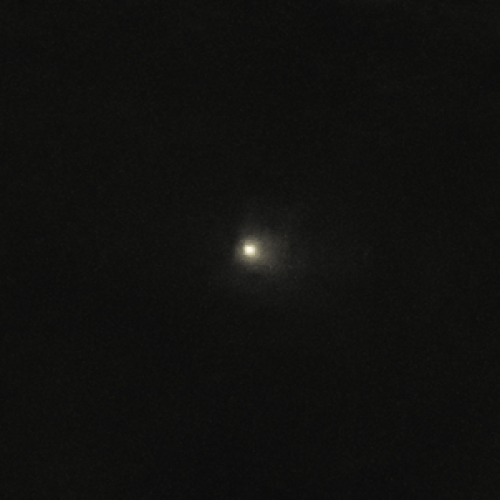
Image: Observations with ESO’s Very Large Telescope, and the Canada France Hawaii Telescope, show that C/2014 S3 (Pan-STARRS) is the first object to be discovered that is on a long-period cometary orbit, but that has the characteristics of a pristine inner Solar System asteroid. It may provide important clues about how the Solar System formed. This image of the comet was acquired using the Canada France Hawaii Telescope. Credit: K. Meech (IfA/UH) / CFHT/ESO.
A population of objects of the C/2014 S3 class would be useful indeed, and as this University of Hawaii Institute for Astronomy news release suggests, would help us differentiate between differing models of Solar System development. The problem is that while several of these models can duplicate the Solar System’s current configuration, some require the migration of the gas giants while others do not. Moreover, the models yield different predictions on the amount of rocky material expelled early on into the Oort Cloud.
Just how widely these models vary is explained in the paper. Here it describes the gas giant migration model:
The “Grand Tack” model starts the simulation of solar system formation at an early phase, when the giant planets grew and migrated in a gas-rich protoplanetary disk. During their inward migration, the giant planets scattered inner solar system material outward; during their outward migration, they implanted a significant amount of icy planetesimals [from 3.5 to 13 astronomical units (AU)] into the inner solar system. The Grand Tack model predicts the presence of rocky objects in the Oort cloud at an icy comets/rocky asteroids ratio of 500:1 to 1000:1…
But how we view the Oort Cloud varies depending upon which model we accept:
Other dynamical models, which assume nonmigrating giant planets, make different predictions about the fraction of the Oort cloud population comprising planetesimals initially within the asteroid belt or the terrestrial planet region. These predictions range from 200:1 to 2000:1. Other models do not explicitly estimate the mass of rocky planetesimals eventually implanted in the Oort cloud, but from the amount initially available, it is reasonable to expect that the ratio of icy planetesimals to rocky planetesimals in the final Oort cloud is between 200:1 to 400:1. Instead, a recent radically different model of terrestrial planet formation predicts that the planetesimals in the inner solar system always had a negligible total mass; in this case, there would be virtually no rocky Oort cloud population.
Be aware that C/2014 S3 is not the first inactive object discovered on a long-period comet orbit, with 1996 PW, found in 1996, being characterized as an extinct comet or asteroid ejected into the Oort Cloud. Five other ‘Manx candidates’ have been observed by Meech’s team, all of them showing colors similar to 1996 PW. C/2014 S3 is the only candidate to date that shows the spectrum of an S-type asteroid, a type usually found in the main asteroid belt.
So it’s an intriguing find, and according to the paper, learning how many S-type objects like it exist in the Oort Cloud will be a useful test of the various models. The paper argues that making a selection between the models will require characterization of up to 100 such ‘Manx objects,’ with the number of S-types helping us determine the ratio of icy to rocky objects in the Oort. As we are now discovering Manx objects on the order of about 15 per year as the Pan-STARRS project continues, scientists will soon have a sufficient number to work with.
The paper is Meech et al., “Inner solar system material discovered in the Oort cloud,” Science Advances Vol. 2, No. 4 (29 April 2016). Full text.

Perspectives on Cosmic Archaeology
I’ve always found the final factor in the Drake Equation to be the most telling. Trying to get a rough idea of how many other civilizations there might be in the galaxy, Drake looked at factors ranging from the rate of star formation to the fraction of planets suitable for life on which life actually appears. Some of these items, like the fraction of stars with planets, are being clarified almost by the day with continuing work. But the big one at the end — the lifetime of a technological civilization — remains a mystery.
By ‘technological,’ Drake was referring to those civilizations that were capable of producing detectable signals; i.e., releasing electromagnetic radiation into space. And when we have but one civilization to work with as example, we’re hard pressed to know what this factor is. This is where Adam Frank (University of Rochester) and Woodruff Sullivan (University of Washington, Seattle) come into the picture. In a new paper in Astrobiology, the researchers argue that there are other ways of addressing the ‘lifetime’ question.

Image credit: http://www.ForestWander.com [CC BY-SA 3.0 us], via Wikimedia Commons.
What Came Before Us
The idea is to calculate how unlikely our advanced civilization would be if none has ever arisen before us. In other words, Frank and Sullivan want to put a lower limit on the probability that technological species have, at any time in the past, evolved elsewhere than on Earth. Here’s how their paper describes this quest:
Standard astrobiological discussions of intelligent life focus on how many technological species currently exist with which we might communicate (Vakoch and Dowd, 2015). But rather than asking whether we are now alone, we ask whether we are the only technological species that has ever arisen. Such an approach allows us to set limits on what might be called the ”cosmic archaeological question”: How often in the history of the Universe has evolution ever led to a technological species, whether short- or long-lived? As we shall show, providing constraints on an answer to this question has profound philosophical and practical implications.
To do this, the authors produce their own equation drawing on Drake’s. Consider A the number of technological civilizations that have formed over the history of the observable universe. Rather than dealing with Drake’s factor L — the lifetime of a technological civilization — Frank and Sullivan propose what they call an ‘archaeological form’ of Drake’s equation. The need for the L factor disappears. The new equation appears in this form:
A = Nast * fbt
Where A = The number of technological species that have evolved at any time in the universe’s past
Nast = The number of habitable planets in a given volume of the universe
fbt = The likelihood of a technological species arising on one of these planets.
You can see that what Frank and Sullivan rely on are recent advances in the detection and characterization of exoplanets. We’re learning a great deal more about how common planets are and how many are likely to orbit in the habitable zone around their star, where liquid water could exist. Their term Nast relies on this work and draws together various terms from the original Drake equation including the total number of stars, the fraction of those stars that form planets, and the average number of planets in the habitable zone of their stars.
From the paper:
With our approach we have, for the first time, provided a quantitative and empirically constrained limit on what it means to be pessimistic about the likelihood of another technological species ever having arisen in the history of the Universe. We have done so by segregating newly measured astrophysical factors from the fully unconstrained biotechnical ones, and by shifting the focus toward a question of ”cosmic archaeology” and away from technological species lifetimes. Our constraint addresses an issue that is of particular scientific and philosophical consequence: the question ”Have they ever existed?” rather than the usual narrower concern of the Drake equation, ”Do they exist now?”
The paper is short and interesting; I commend it to you. The result it produces is that human civilization can be considered unique in the cosmos only if the odds of a civilization developing are less than one part in 10 to the 22nd power. Frank and Sullivan call this the ‘pessimism’ line. If the probability of a technological civilization developing is greater than this standard, then we can assume civilizations have formed before us at some time in the universe’s history.
And yes, this is a tiny number — one in ten billion trillion. Frank says in this University of Rochester news release that he believes it implies technology-producing species have evolved before us. Even if the chances of civilization arising were one in a trillion, there would be about ten billion civilizations in the observable universe since the first one arose. As for our own galaxy, another civilization is likely to have appeared at some point in its history if the odds against it evolving on any one habitable planet are better than one in 60 billion.
We fall back on cosmic archaeology in suggesting that given the size and age of the universe, Drake’s factor L may still play havoc with our chances of ever contacting another civilization. Sullivan puts it this way:
“The universe is more than 13 billion years old. That means that even if there have been a thousand civilizations in our own galaxy, if they live only as long as we have been around—roughly ten thousand years—then all of them are likely already extinct. And others won’t evolve until we are long gone. For us to have much chance of success in finding another “contemporary” active technological civilization, on average they must last much longer than our present lifetime.”
We can play with this a bit. Taking the Milky Way and choosing a probability of 3 X 10-9, we are likely to be one of hundreds of civilizations that have arisen. But drop that probability to 10-18 (one in a billion billion) and we are likely the first advanced civilization in the galaxy. Yet even with the latter constraint, that would still mean we are one of thousands of civilizations that have developed at some time in the visible universe.
I always appreciate work that frames an issue in a new perspective, which is what Frank and Sullivan’s paper does. We can’t know whether there are other civilizations currently active in our galaxy, but it appears that the odds favor their having arisen at some time in the past. In fact, these numbers show us that we are almost certainly not the first technological civilization to have emerged. Is the galaxy filled with the ruins of civilizations that were unable to survive, or is it a place where some cultures have mastered the art of keeping themselves alive?
The paper is Frank and Sullivan, “A New Empirical Constraint on the Prevalence
of Technological Species in the Universe,” Astrobiology Vol. 16, No. 5 (2016). Preprint available.

TRAPPIST-1: Three Nearby Worlds
About forty light years from Earth in the constellation Aquarius is the star designated 2MASS J23062928-0502285, which as of today qualifies as perhaps the most interesting ultracool dwarf we’ve yet found. What we learn in a new paper in Nature is that the star, also known as TRAPPIST-1 after the European Southern Observatory’s TRAPPIST telescope at La Silla, is orbited by three planets that are roughly the size of the Earth. We may have a world of astrobiological interest — and conceivably several — orbiting this tiny, faint star.
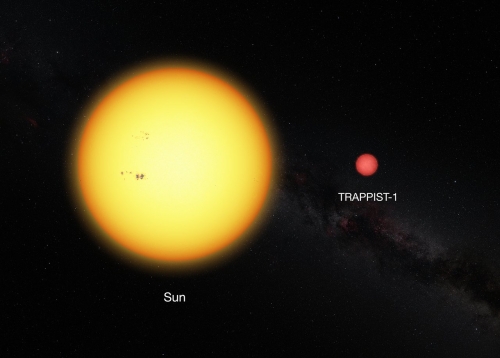
Image: Comparison between the Sun and the ultracool dwarf star TRAPPIST-1. Credit: ESO.
If we untangle the TRAPPIST acronym, we find that it refers not to an order of monks (famous for their beers) but to the TRAnsiting Planets and PlanetesImals Small Telescope, a 60 cm robotic instrument that is operated from a control room in Liège, Belgium. TRAPPIST homes in on sixty nearby dwarf stars at infrared wavelengths to search for planets. Michaël Gillon, who led the team from the University of Liège that made the recent discovery, nails its significance:
“Why are we trying to detect Earth-like planets around the smallest and coolest stars in the solar neighbourhood? The reason is simple: systems around these tiny stars are the only places where we can detect life on an Earth-sized exoplanet with our current technology. So if we want to find life elsewhere in the Universe, this is where we should start to look.”
In other words, life may exist on many worlds, and many of us believe that it does. But at our current level of equipment and expertise, a star like TRAPPIST-1 is significant because the star is small and dim enough for the atmospheres of Earth-sized planets to be studied. We learn from the Nature paper that two of the planets here have orbital periods of 1.5 days and 2.4 days respectively. The third is not as well characterized, with its orbit in a range from 4.5 to 73 days despite follow-up work with ESO’s 8-metre Very Large Telescope in Chile.
Noting how close the planets are to the host star, Gillon likens the scale of the system to that of Jupiter and its larger moons. These are worlds twenty to one hundred times closer to their star than the Earth is to the Sun, but the two inner planets receive only twice and four times respectively the stellar radiation that the Earth receives from the Sun. That puts them too close to the star to be in the habitable zone, while the outer planet may possibly lie within it.
But bear in mind that at least the inner two planets are probably tidally locked, with one side perpetually facing the star, the other turned away from it. Hence there may be regions near the terminator that receive daylight but maintain relatively cool temperatures. Given that the third planet may turn out to be entirely within the habitable zone, we have a fascinating test case for upcoming attempts to characterize the atmospheres of each of these Earth-sized worlds.
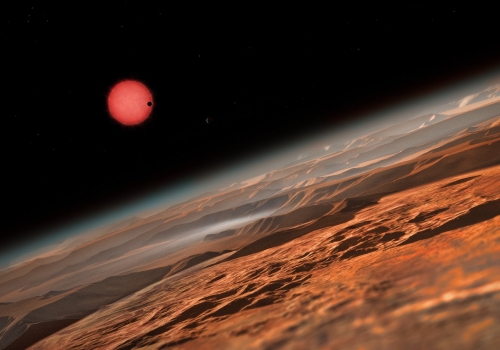
Image: Artist’s impression of the ultracool dwarf star TRAPPIST-1 from close to one of its planets. Credit: ESO.
This ESO news release quotes Julien de Wit, a co-author of the paper on this work, with regard to where we go next:
“Thanks to several giant telescopes currently under construction, including ESO’s E-ELT and the NASA/ESA/CSA James Webb Space Telescope due to launch for 2018, we will soon be able to study the atmospheric composition of these planets and to explore them first for water, then for traces of biological activity. That’s a giant step in the search for life in the Universe.”
The paper is Gillon et al., “Temperate Earth-sized Planets Transiting a Nearby Ultracool Dwarf Star,” published online in Nature 2 May 2016 (abstract). I’ll note too the continuing interest Centauri Dreams reader Harry R. Ray has shown in TRAPPIST 1, and thank him for bringing it to my attention before these first news reports surfaced.

Spacecoaches and Beamed Power
If you’re planning to make it to the International Space Development Conference in San Juan, Puerto Rico next month, be advised that Brian McConnell will be there with thoughts on a subject we’ve discussed in several earlier posts: A ‘spacecoach’ that uses water as a propellant and offers a practical way to move large payloads (and crews) around the Solar System. Based in San Francisco, Brian is a technology entrepreneur who doubles as a software/electrical engineer. In the essay below, he looks at the spacecoach in relation to the Breakthrough Starshot initiative, where synergies come into play that may benefit both concepts.
by Brian McConnell
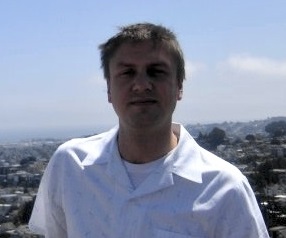
The spacecoach is a design pattern for a reusable solar electric spacecraft, previously featured on Centauri Dreams here and developed in A Design for a Reusable Water-Based Spacecraft Known as the Spacecoach (Springer Verlag), which I wrote with Alex Tolley. It primarily uses water as its propellant. This design has numerous benefits, chief among them the ability to turn consumables, ordinarily deadweight, into working mass.
The recent announcement of the Breakthrough Starshot project, which aims to use beamed power to drive ultra lightweight lightsail probes on interstellar trajectories, is of note. This same infrastructure could be used to augment the capabilities and range of spacecoaches (or any solar electric spacecraft), while providing a near-term use for beamed power infrastructure as it is developed and scaled up.
The spacecoach design pattern combines a medium sized solar array (sized to generate between 500 kilowatts and 2 megawatts of peak power at 1AU) with electric propulsion units that use water as propellant (and possibly also waste streams such as carbon dioxide, ammonia, etc). We found that, even when constrained to these power levels, they could fly approximately Hohmann trajectories to and from destinations in the inner solar system. Because consumables are converted into propellant, this reduces mass budgets by an order of magnitude, and effectively eliminates the need for an external interplanetary stage, all while greatly simplifying the logistics of supporting a sizeable crew for long duration missions (more consumables = more propellant).
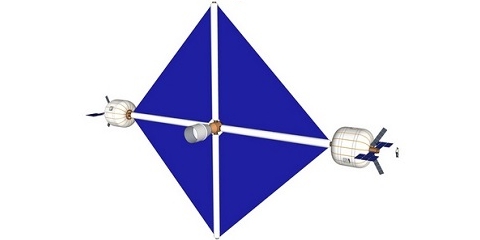
The primary constraint for space coaches, especially if you want to travel to the outer solar system, is available power. This is an issue for two reasons. First, solar flux drops off by 1/r2, so at Jupiter, a solar array will generate roughly 1/25th the power as it does at Earth distance. Second, trips to more distant locations will typically require a greater delta V (and thus higher exhaust velocity to achieve this with a given amount of propellant). The amount of energy required to generate a unit of impulse scales linearly with exhaust velocity, so the net result is the ship’s power requirements are increased, all while the powerplant’s power density (watts per kilogram of solar array) is decreased.
Testing Beamed Power
Beamed power infrastructure would enable space coaches and solar electric spacecraft in general to operate at higher power levels for a given array size, which would enable them to operate at higher thrust levels, and to utilize higher exhaust velocities to maximize delta V and propellant efficiency. This means they would be able to accelerate faster, achieve higher delta-v, while using less propellant. In effect beamed power to SEP spacecraft will give their operators the equivalent of a nuclear electric power plant (without the nukes).
A spacecoach built for solar only operation would be able to serve as a testbed for beamed power. For example, a space coach departing Earth orbit could be illuminated with a beam that increases its power output by a small amount, say 10% (large enough to make a measurable difference in performance, yet small enough that major modifications are not required to the ship as it just experiences slightly brighter illumination while in beam). At higher light levels, this technique could also be used to simulate lighting and heat loading conditions expected at the inner planets while remaining in near Earth space. Note also that lasers can be tuned to the absorption wavelength(s) of the photovoltaic material, greatly improving conversion efficiency (and reducing heat gain per unit of power delivered). An even cheaper way to build out and test power beaming infrastructure will be with satellites and probes that utilize solar electric propulsion.
The pathway to a system based primarily on beamed power then becomes one based on incremental improvements, both for the ground based facilities and for the ships. This would result in near term applications for the beamed power facilities while the much more technically challenging aspects of the starshot project are sorted out. Meanwhile, satellite and space coach operators could test ships with ever higher levels of beamed power until they hit a limit (heat rejection is probably the main limit to how much power can be concentrated per unit of sail area, as this is similar to concentrated photovoltaics).
The chart below illustrates the power/performance curve by showing the amount of impulse that can theoretically be generated per megawatt hour using electric propulsion, as a function of exhaust velocity. Real world performance will be somewhat lower due to efficiency losses, but this shows the relationship between thrust, ve and power. We see that impulse per MWh varies from 72,000 kg-m/s (ion drive, ve ~ 100,000 m/s) to 1,400,000 kg-m/s (RF arcjet, ve ~ 5000 m/s). A Hall Effect thruster, a flight proven technology, would yield about 300,000 kg-m/s per MWh. Compare this to pure photonic propulsion, which would yield only 12 to 24 kg-m/s per MWh. Clearly photonic propulsion will be necessary to achieve a delta v of 0.2c, but for more pedestrian applications such as satellite orbit raising, launching interplanetary probes or cargo ships from LEO to BEO (beyond earth orbit), electric propulsion will work well at power levels many orders of magnitude lower than what’s required for a starshot.
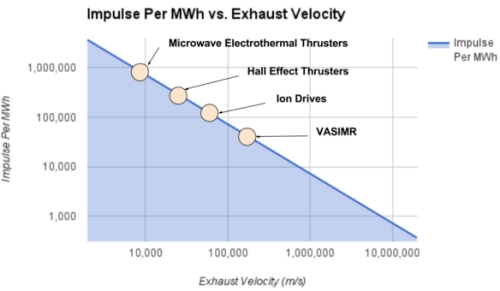
Driver for an Interplanetary Infrastructure?
Closer to home there could be lots of opportunities to sell beamed power to space operators. It’s costly to launch large payloads beyond low earth orbit (which isn’t cheap in the first place). Meanwhile, payload fairings limit the size of self-deploying solar arrays, which limits the use of electric propulsion for satellites and probes. If one could launch spacecraft with small solar arrays to LEO, and then use beamed power to amplify their power budget they could use electric propulsion to boost themselves to their desired orbits or interplanetary trajectories within a reasonable time frame. The beamed power infrastructure can also be built up incrementally. Early systems would beam 100 kilowatts to 10 megawatts of power to targets measuring meters to tens of meters in diameter. This should be readily achievable, and can be scaled up from there in terms of power output, beam precision, etc. The result: lower costs per kilogram to deliver a payload to its destination or desired orbit compared to all chemical propulsion.
This could make electric propulsion for transit from LEO to GEO and beyond an attractive option. Meanwhile, the power beaming operator would accrue lots of operational experience with beam shaping, tracking objects in orbit, etc, all things that will need to be mastered for the starshot project, while providing an economic foundation for the power beaming facilities during the buildup to their intended purpose.
In fact, one can imagine the starshot project becoming a profitable LEO to BEO (beyond earth orbit) launch operator in its own right. The terrestrial power beaming infrastructure is one component. A standardized “power sail” that can be fitted to many different payloads, from geostationary satellites to interplanetary probes, is another. The power sail would consist of a self-deploying solar array that is sized to work well with beamed power, heat rejection gear, and electric propulsion units. It would use beamed power during its boost phase to rapidly accrue velocity for its planned trajectory, and then as it leaves near Earth space, would transition to use ambient light as its power source from there. Meanwhile these power sails would provide an evolutionary path from conventional spacecraft to solar electric propulsion to the nanocraft envisioned for purely photonic propulsion.
As a starting point, it would be interesting to conduct ground based vacuum chamber tests to see how a variety of PV materials respond to being illuminated with concentrated laser light tuned to their peak absorption wavelengths. What do the conversion efficiencies look like? How much waste heat is generated? How do the materials perform at high temperatures in simulated in-beam conditions? Building on that one can imagine experiments involving cubesats to validate the data from those experiments in real world conditions, and if that all works out, one could scale up from there to build out beamed power infrastructure for use by many types of solar electric vehicles.
Ambitious R&D projects have a way of generating unintended side benefits. It’s possible that the starshot initiative, in addition to being our first step toward the stars, will also make great contributions to travel and exploration within the solar system.

Light’s Echo: Protoplanetary Disk Examined
The star YLW 16B, about 400 light years from the Earth, has roughly the same mass as the Sun. But unlike the Sun, a mature 4.6 billion year old star, YLW 16B is a scant million years old, a variable of the class known as T Tauri stars. Whereas our star is relatively stable in terms of radiation emission, the younger star shows readily detectable changes in radiation, a fact that astronomers have now used in combining data from the Spitzer space telescope with four ground-based instruments to learn more about the dimensions of its protoplanetary disk.

Image: This illustration shows a star surrounded by a protoplanetary disk. Material from the thick disk flows along the star’s magnetic field lines and is deposited onto the star’s surface. When material hits the star, it lights up brightly. Credit: NASA/JPL-Caltech.
The method is called photo reverberation, and it takes advantage of the fact that when the star brightens as material from the turbulent disk falls onto its surface, some of the emitted light strikes the disk. The result is what is known as a ‘light echo,’ a delayed flash that can be used to measure how far the star is from the inner edge of the surrounding disk.
The time lag between the stellar emissions and their ‘echoes’ is what is in play here. Over the course of a two-night observing period, the researchers found consistent time lags between emissions and echoes. On the ground, the Mayall telescope at Kitt Peak (Arizona), the Harold L. Johnson telescope in Mexico and the SOAR and SMARTS telescopes in Chile could measure shorter-wavelength infrared wavelengths — these emissions came from the star. Spitzer, meanwhile, measured longer-wavelength light from the disk’s echo. From the paper:
Near-simultaneous time-series photometric observations were conducted on April 20, 22, and 24, 2010, with four ground-based telescopes operating in H and K bands and the Spitzer Space Telescope observing at 4.5 µm. Each session of Spitzer staring mode monitoring lasted ?8 hours. One (YLW 16B) out of twenty-seven sources detected was found to have mutually correlated hourly variations in all three wavebands. Over all three nights, the time series measurements of YLW 16B in H and K bands are consistently synchronized, while the light curve at 4.5 µm lags behind both H and K by 74.5±3.2 seconds over the first two nights when we have usable 4.5 µm data.
From this we learn that the light must have traveled about 0.084 AU between emission and echo (with an uncertainty on the order of 0.01 AU), meaning the inner edge of the protoplanetary disk reaches in as far as one-quarter the diameter of Mercury’s orbit. The paper notes that the structure of the inner region of a protoplanetary disk depends on the mechanism by which material from the disk accretes onto the star. At work at this inner boundary is sublimation, affecting dust, and the forces of the stellar magnetosphere that shape gas distribution.

Image: The star’s irregular illumination allows astronomers to measure the gap between the disk and the star by using a technique called “photo-reverberation” or “light echoes.” First, astronomers look at how much time it takes for light from the star to arrive at Earth. Then, they compare that with the time it takes for light from the star to bounce off the inner edge of the disk and then arrive at Earth. That time difference is used to measure distance, as the speed of light is constant. Credit: NASA/JPL-Caltech.
We’ve learned much about disk structure by studying disks around larger mass stars, but until now probing into the inner disk regions of pre-main sequence T Tauri stars like YLW 16B has been hampered by the proximity of the inner disk edge to the star, too small to be directly imaged. Measuring the light travel time from the young star to the inner disk wall thus breaks new ground. The authors believe the method is viable for other young stars that show variability in the near-infrared, giving us a way to measure disks where planet formation has yet to begin.
For more on light echoes, see ‘Light Echo’ Reveals Eta Carinae Puzzle, which looks at the technique in terms of supernovae. To my knowledge, this is the first time light echoes have been studied in relation to protoplanetary disks. The paper is Meng et al., “Photo-reverberation Mapping of a Protoplanetary Accretion Disk around a T Tauri Star,” accepted for publication in the Astrophysical Journal (preprint). A JPL news release is also available.


